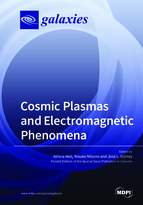Cosmic Plasmas and Electromagnetic Phenomena
A special issue of Galaxies (ISSN 2075-4434).
Deadline for manuscript submissions: closed (7 November 2018) | Viewed by 48436
Special Issue Editors
Interests: cosmic-rays; high-energy astrophysics; relativistic jets; extragalactic astronomy
Special Issues, Collections and Topics in MDPI journals
Interests: high-energy astrophysics; plasma astrophysics; relativistic astrophysics; black hole; relativistic jets; active galactic nuclei; gamma-ray bursts; pulsar wind nebula; accretion disks; shock; instability; turbulence; GRMHD & RMHD simulations
Interests: high energy astrophysics; active galactic nuclei; relativistic jets; blazars; RMHD simulations; very long baseline interferometry; radio-astronomy; multi-waveband observations
Special Issue Information
Dear Colleagues,
During the last few decades, plasma science has witnessed a great growth in laboratory studies, simulations and in space. Plasma is the most common phase of ordinary matter in the universe. It is a state in which ionized matter (even as low as 1%) becomes highly electrically conductive, and, as such, long range electric and magnetic fields dominate its behavior. Cosmic plasmas are mostly associated with stars, supernovae, pulsars and neutron stars, quasars and active galaxies, mostly at their central black-holes (i.e., jets, accretion disks). Cosmic plasma phenomena are studied with different methods such as laboratory experiments, astrophysical observations and computational approaches (i.e., MHD or Particle-In-Cell simulations, etc.), exhibiting a multitude of complex magnetohydrodynamic behaviors, acceleration, radiation, turbulence and various instability phenomena. This Special Issue will aim to address the growing need of the plasma science principles in astrophysics and to present our current understanding of the physics of astrophysical plasmas, their electromagnetic behaviors and properties, such as shocks, waves, turbulence, instabilities, collimation, acceleration and radiation, microscopically and macroscopically. Therefore, our purpose will be to provide an up-to-date overview of the cosmic plasma studies widely through astrophysical observations, laboratory experiments, simulation techniques, and theoretical models.
References:
- Jorstad et al. 2017: http://adsabs.harvard.edu/abs/2017ApJ...846...98J
- Lister et al. 2009: http://adsabs.harvard.edu/abs/2009AJ....137.3718L
- Ghisellini et al. 2010: http://adsabs.harvard.edu/abs/2010MNRAS.402..497G
- Doeleman et al. 2008: http://adsabs.harvard.edu/abs/2008Natur.455...78D
- Falcke et al. 2004: http://adsabs.harvard.edu/abs/2004A%26A...414..895F
- Font 2008: http://adsabs.harvard.edu/abs/2008LRR....11....7F
- Sironi et al. 2015: http://adsabs.harvard.edu/abs/2015SSRv..191..519S
- McKinney & Blandford 2012: http://adsabs.harvard.edu/abs/2009MNRAS.394L.126M
- Kronberg, P. P., Lovelace, R. V. E., Lapenta, G., Colgate, S. A., 2011: http://adsabs.harvard.edu/abs/2011ApJ...741L..15K
- Christodoulou, D. M., Gabuzda, D. C., Knuettel, S., Contopoulos, I., Kazanas, D., Coughlan, C. P., 2016: http://adsabs.harvard.edu/abs/2016A%26A...591A..61C
Dr. Athina Meli
Dr. Yosuke Mizuno
Dr. Jose L. Gómez
Guest Editors
Manuscript Submission Information
Manuscripts should be submitted online at www.mdpi.com by registering and logging in to this website. Once you are registered, click here to go to the submission form. Manuscripts can be submitted until the deadline. All submissions that pass pre-check are peer-reviewed. Accepted papers will be published continuously in the journal (as soon as accepted) and will be listed together on the special issue website. Research articles, review articles as well as short communications are invited. For planned papers, a title and short abstract (about 100 words) can be sent to the Editorial Office for announcement on this website.
Submitted manuscripts should not have been published previously, nor be under consideration for publication elsewhere (except conference proceedings papers). All manuscripts are thoroughly refereed through a single-blind peer-review process. A guide for authors and other relevant information for submission of manuscripts is available on the Instructions for Authors page. Galaxies is an international peer-reviewed open access semimonthly journal published by MDPI.
Please visit the Instructions for Authors page before submitting a manuscript. The Article Processing Charge (APC) for publication in this open access journal is 1400 CHF (Swiss Francs). Submitted papers should be well formatted and use good English. Authors may use MDPI's English editing service prior to publication or during author revisions.








